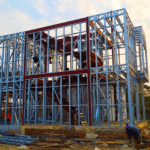The Future of Prefabrication in Construction

The construction industry has been witnessing a paradigm shift over the past few years, with prefabrication emerging as a game-changer. As we move into 2024, the role of prefabrication in construction is set to expand even further, driven by technological advancements, sustainability demands, and the need for greater efficiency. Here’s a look at the key trends shaping the future of prefabrication in construction.
Advancements in Modular Construction
Modular construction, where buildings are assembled from pre-made sections, is expected to gain more traction in 2024. This method reduces on-site construction time, lowers costs, and minimizes waste. With improvements in design flexibility and material quality, modular construction is no longer just for temporary structures but is increasingly being used for permanent, high-quality buildings, including residential, commercial, and even educational facilities.
Integration of Smart Technologies
The integration of smart technologies is set to revolutionize prefabrication. From Building Information Modeling (BIM) to the Internet of Things (IoT), these technologies allow for greater precision and efficiency in the design, manufacturing, and assembly processes. BIM, in particular, enables real-time collaboration among architects, engineers, and contractors, ensuring that prefabricated components like shear studs and deck sheets are perfectly aligned with the overall building design.
Sustainability Takes Center Stage
Sustainability is no longer an option but a necessity in today’s construction landscape. Prefabrication offers a more sustainable approach by reducing waste, improving energy efficiency, and utilizing eco-friendly materials. In 2024, we expect to see an increased emphasis on green building certifications and the use of recycled or renewable materials in prefabricated components. Additionally, the carbon footprint of transportation and assembly processes is likely to be scrutinized, pushing the industry toward more localized production facilities.
Increased Use of Prefabricated Shear Studs and Deck Sheets
As the demand for stronger, more durable structures continues to grow, the use of prefabricated shear studs and deck sheets is expected to rise. These components are essential for reinforcing concrete and ensuring structural stability, particularly in high-rise buildings and infrastructure projects. Prefabrication of these elements not only speeds up construction but also enhances quality control, as they are manufactured in controlled environments with rigorous testing procedures.
Offsite Construction and Assembly
The trend toward offsite construction is accelerating, with more projects being partially or fully assembled away from the construction site. This approach offers numerous benefits, including reduced labor costs, improved safety, and shorter project timelines. In 2024, we can expect more companies to invest in offsite manufacturing facilities, particularly for complex components like prefabricated shear studs and deck sheets. This shift is also likely to drive innovations in transportation and logistics, ensuring that prefabricated elements reach the site efficiently and intact.
Automation and Robotics in Prefabrication
Automation and robotics are set to play a significant role in the future of prefabrication. Automated machinery and robotic systems can handle repetitive tasks with precision, increasing production speed and reducing human error. For instance, robots can be employed to weld shear studs to metal decks with high accuracy, ensuring consistent quality across all components. As technology continues to evolve, we may see fully automated factories dedicated to producing prefabricated building elements.
Customization and Personalization
While prefabrication has traditionally been associated with uniformity, advances in technology are enabling greater customization and personalization. In 2024, we expect to see more options for bespoke prefabricated components, tailored to the specific needs of individual projects. This trend will allow architects and builders to maintain the aesthetic and functional uniqueness of their designs while benefiting from the efficiency of prefabrication.
Collaboration Across the Supply Chain
The future of prefabrication will be marked by increased collaboration across the supply chain. Manufacturers, designers, and contractors will need to work closely together from the early stages of a project to ensure that prefabricated elements are seamlessly integrated into the overall construction plan. This collaborative approach will not only improve project outcomes but also help in overcoming challenges such as supply chain disruptions and material shortages.
Conclusion
As we look ahead to 2024, it’s clear that prefabrication is poised to play an even more critical role in the construction industry. With advancements in technology, a growing focus on sustainability, and the rise of modular and offsite construction, prefabrication is transforming how we build. By staying ahead of these trends, companies can position themselves at the forefront of the industry, delivering projects that are not only faster and more cost-effective but also more innovative and environmentally friendly.
Prefabrication is not just a trend; it’s the future of construction. And that future is happening now.






















